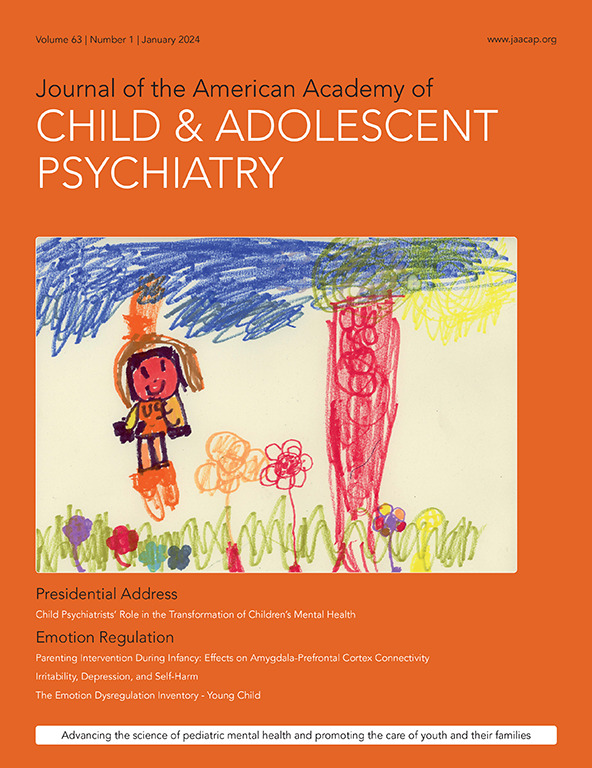Prospective 2-Year Course and Predictors of Outcome in Avoidant/Restrictive Food Intake Disorder
IF 9.2
1区 医学
Q1 PEDIATRICS
Journal of the American Academy of Child and Adolescent Psychiatry
Pub Date : 2025-02-01
DOI:10.1016/j.jaac.2024.04.010
引用次数: 0
Abstract
Objective
To evaluate the 2-year course and outcomes of full and subthreshold avoidant/restrictive food intake disorder (ARFID) in youth aged 9 to 23 years at baseline using a prospective longitudinal design to characterize the remission and persistence of ARFID, evaluate diagnostic crossover, and identify predictors of outcome. Greater severity in each ARFID profile—sensory sensitivity, fear of aversive consequences, and lack of interest—was hypothesized to predict greater likelihood of illness persistence, controlling for age, sex, body mass index percentile, ARFID treatment status, and baseline diagnosis.
Method
Participants (N = 100; age range, 9-23 years; 49% female; 91% White) were followed over 2 years. The Pica, ARFID, and Rumination Disorder Interview was used across 3 time points (baseline, year 1, year 2) to measure the severity of each ARFID profile and evaluate illness persistence or remission, and the Eating Disorder Assessment for DSM-5 was used to evaluate diagnostic crossover.
Results
Across the 2-year follow-up period, half the participants persisted with their original diagnosis, and 3% of participants experienced a diagnostic shift to anorexia nervosa. Greater severity in the sensory sensitivity and lack of interest profiles was associated with higher likelihood of ARFID persistence at year 1 only; greater severity in the fear of aversive consequences profile was associated with higher likelihood of ARFID remission at year 2 only.
Conclusion
Findings underscore the distinctiveness of ARFID from other eating disorders and emphasize its persistence over 2 years. Results also highlight the predictive validity and prognostic value of the ARFID profiles (ie, sensory sensitivity, fear of aversive consequences, lack of interest).
Plain language summary
In this longitudinal study, the authors examined the course and outcomes of avoidant/restrictive food intake disorder (ARFID) in a sample of 100 youth aged 9 to 23 years over the course of 2 years. Across the 2-year follow-up period, half the sample persisted with their original diagnosis, and 3% of participants developed anorexia nervosa. Results indicate that profiles of greater sensory sensitivity to food and lack of interest in food/eating were associated with higher likelihood of ARFID persistence at year 1 only, whereas greater severity in the fear of aversive consequences of eating was associated with higher likelihood of ARFID remission at year 2 only. These findings highlight the persistence of ARFID and suggest that outcomes may vary depending on an individual’s ARFID presentation.
回避型/限制型食物摄入障碍患者两年的前瞻性病程和结果预测。
目的采用前瞻性纵向设计,评估9-23岁青少年完全和亚阈值回避型/限制性食物摄入障碍(ARFID)的两年病程和基线结果,以描述ARFID的缓解和持续情况,评估诊断交叉,并确定结果预测因素。我们假设,在控制年龄、性别、BMI 百分位数、ARFID 治疗状态和基线诊断的情况下,ARFID 各项特征(感觉敏感、害怕厌恶性后果和缺乏兴趣)的严重程度越高,疾病持续存在的可能性就越大:我们对参与者(N = 100;年龄 9-23 岁;49% 为女性,91% 为白人)进行了为期两年的跟踪调查。我们在三个时间点(基线、第一年、第二年)使用Pica、ARFID和反刍障碍访谈来测量每个ARFID特征的严重程度,评估疾病的持续或缓解情况,并使用DSM-5饮食失调评估来评估诊断交叉:结果:在为期 2 年的随访期间,半数样本坚持了原来的诊断,3% 的参与者诊断为神经性厌食症。仅在第一年,感觉敏感和缺乏兴趣特征的严重程度越高,ARFID持续存在的可能性越大;仅在第二年,对厌恶性后果的恐惧特征的严重程度越高,ARFID缓解的可能性越大:结论:研究结果强调了ARFID与其他进食障碍的不同之处,并强调了其在两年内的持续性。研究结果还强调了 ARFID 特征(即感官敏感性、对厌恶性后果的恐惧、缺乏兴趣)的预测有效性和预后价值。
本文章由计算机程序翻译,如有差异,请以英文原文为准。
求助全文
约1分钟内获得全文
求助全文
来源期刊
CiteScore
21.00
自引率
1.50%
发文量
1383
审稿时长
53 days
期刊介绍:
The Journal of the American Academy of Child & Adolescent Psychiatry (JAACAP) is dedicated to advancing the field of child and adolescent psychiatry through the publication of original research and papers of theoretical, scientific, and clinical significance. Our primary focus is on the mental health of children, adolescents, and families.
We welcome unpublished manuscripts that explore various perspectives, ranging from genetic, epidemiological, neurobiological, and psychopathological research, to cognitive, behavioral, psychodynamic, and other psychotherapeutic investigations. We also encourage submissions that delve into parent-child, interpersonal, and family research, as well as clinical and empirical studies conducted in inpatient, outpatient, consultation-liaison, and school-based settings.
In addition to publishing research, we aim to promote the well-being of children and families by featuring scholarly papers on topics such as health policy, legislation, advocacy, culture, society, and service provision in relation to mental health.
At JAACAP, we strive to foster collaboration and dialogue among researchers, clinicians, and policy-makers in order to enhance our understanding and approach to child and adolescent mental health.

 求助内容:
求助内容: 应助结果提醒方式:
应助结果提醒方式:


